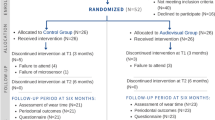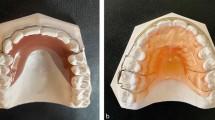Abstract
Patient adherence to removable retainer wear is integral to the long-term success of retention regimes. We discuss the factors influencing removable retainer wear, the methods of gauging wear levels, approaches to enhance adherence and the quality of online available information concerning retention. The potential value of patient involvement in approaches to retention within a shared decision-making framework and motivational interviewing are also highlighted.
Key points
-
Adherence to removable retainer wear is multifaceted but undoubtedly onerous in the longer term.
-
Subjective assessment of retainer wear is unreliable, being invariably overestimated.
-
Approaches to enhancing compliance and long-term outcomes including shared decision-making and motivational interviewing, as well as the nature and impact of online and electronic resources, are also presented.
This is a preview of subscription content, access via your institution
Access options
Subscribe to this journal
Receive 24 print issues and online access
$259.00 per year
only $10.79 per issue
Buy this article
- Purchase on Springer Link
- Instant access to full article PDF
Prices may be subject to local taxes which are calculated during checkout



Similar content being viewed by others
References
Little R M, Riedel R A, Artun J. An evaluation of changes in mandibular anterior alignment from 10 to 20 years postretention. Am J Orthod Dentofacial Orthop 1988; 93: 423-428.
Al-Moghrabi D, Johal A, O'Rourke N et al. Effects of fixed vs removable orthodontic retainers on stability and periodontal health: 4-year follow-up of a randomized controlled trial. Am J Orthod Dentofacial Orthop 2018; DOI: 10.1016/j.ajodo.2018.01.007.
Horne R, Weinman J, Barber N et al. Concordance, adherence and compliance in medicine taking. London: National Co-ordinating Centre for NHS Service Delivery and Organisation R & D, 2005.
Fleming P, Scott P, DiBiase A. Compliance: getting the most from your orthodontic patients. Dent Update 2007; 34: 565-566, 569-570, 572.
Hawley C A. A removable retainer. Int J Orthodont Oral Surg 1919; 5: 291-305.
Nahoum H I. The vacuum formed dental contour appliance. N Y State Dent J 1964; 9: 385-390.
Al-Moghrabi D, Pandis N, McLaughlin K, Johal A, Donos N, Fleming P S. Evaluation of the effectiveness of a tailored mobile application in increasing the duration of wear of thermoplastic retainers: a randomized controlled trial. Eur J Orthod 2020; 42: 571-579.
Vagdouti G, Karvouni E, Bitsanis E, Koletsi D. Objective evaluation of compliance after orthodontic treatment using Hawley or vacuum-formed retainers: A 2-centre randomized controlled trial over a 3-month period. Am J Orthod Dentofacial Orthop 2019; DOI: 10.1016/j.ajodo.2019.07.008.
Al-Moghrabi D, Colonio Salazar F B, Johal A, Fleming P S. Factors influencing adherence to vacuum-formed retainer wear: A qualitative study. J Orthod 2019; 46: 212-219.
Türköz Ç, Bavbek N C, Varlik S K, Akça G. Influence of thermoplastic retainers on Streptococcus mutans and Lactobacillus adhesion. Am J Orthod Dentofacial Orthop 2012; 141: 598-603.
Manzon, L, Fratto, G, Rossi, E, Buccheri A. Periodontal health and compliance: A comparison between Essix and Hawley retainers. Am J Orthod Dentofacial Orthop 2018; 153: 852-860.
Brierley C A, Benson P E, Sandler J. How accurate are TheraMon® microsensors at measuring intraoral wear-time? Recorded vs. actual wear times in five volunteers. J Orthod 2017; 44: 241-248.
Schott T C, Goz G. Applicative characteristics of new microelectronic sensors Smart Retainer(R) and TheraMon(R) for measuring wear time. J Orofac Orthop 2010; 71: 339-347.
Krishnan V. Orthodontics: Newer challenges, modern solutions. J World Fed Orthod 2017; 6: 141.
Castle E, Chung P, Behfar M H et al. Compliance monitoring via a Bluetooth-enabled retainer: A prospective clinical pilot study. Orthod Craniofac Res 2019; 22 Suppl 1: 149-153.
Tsomos G, Ludwig B, Grossen J, Pazera P, Gkantidis N. Objective assessment of patient compliance with removable orthodontic appliances: a cross-sectional cohort study. Angle Orthod 2014; 84: 56-61.
Pratt M C, Kluemper G T, Lindstrom A F. Patient compliance with orthodontic retainers in the postretention phase. Am J Orthod Dentofacial Orthop 2011; 140: 196-201.
Kacer K A, Valiathan M, Narendran S, Hans M G. Retainer wear and compliance in the first 2 years after active orthodontic treatment. Am J Orthod Dentofacial Orthop 2010; 138: 592-598.
Schott T C, Schlipf C, Glasl B, Schwarzer C L, Weber J, Ludwig B. Quantification of patient compliance with Hawley retainers and removable functional appliances during the retention phase. Am J Orthod Dentofacial Orthop 2013; 144: 533-540.
Kourakou M. Objective assessment of patients' compliance with thermoplastic vacuum-formed retainers following fixed appliance therapy. Thessaloniki: Aristotle University of Thessaloniki, 2016. Thesis.
Mirzakouchaki B, Shirazi S, Sharghi R, Shirazi S. Assessment of Factors Affecting Adolescent Patients' Compliance with Hawley and Vacuum Formed Retainers. J Clin Diagn Res 2016; DOI: 10.7860/JCDR/2016/18539.7897.
Hichens L, Rowland H, Williams A et al. Cost-effectiveness and patient satisfaction: Hawley and vacuum-formed retainers. Eur J Orthod 2007; 29: 372-378.
Lin F, Sun H, Ni Z, Zheng M, Yao L. A feasible method to improve adherence of Hawley retainer in adolescent orthodontic patients: a randomized controlled trial. Patient Prefer Adherence 2015; 9: 1525-1530.
Kearney M-K, Pandis N, Fleming P S. Mixed-methods assessment of perceptions of mandibular anterior malalignment and need for orthodontic retreatment. Am J Orthod Dentofacial Orthop 2016; 150: 592-600.
Hyun P, Preston C B, Al-Jewair T S, Park-Hyun E, Tabbaa S. Patient compliance with Hawley retainers fitted with the SMART(®) sensor: a prospective clinical pilot study. Angle Orthod 2015; 85: 263-269.
Ackerman M B, Thornton B. Posttreatment compliance with removable maxillary retention in a teenage population: A short-term randomized clinical trial. Orthodontics (Chic.) 2011; 12: 22-27.
Zotti F, Zotti R, Albanese M, Nocini P F, Paganelli C. Implementing post-orthodontic compliance among adolescents wearing removable retainers through Whatsapp: a pilot study. Patient Prefer Adherence 2019; 13: 609-615.
Alahäivälä T, Oinas-Kukkonen H. Understanding persuasion contexts in health gamification: A systematic analysis of gamified health behaviour change support systems literature. Int J Med Inform 2016; 96: 62-70.
Brown M, O'Neill N, van Woerden H, Eslambolchilar P, Jones M, John A. Gamification and adherence to web-based mental health interventions: a systematic review. JMIR Ment Health 2016; DOI: 10.2196/mental.5710.
Webb T, Joseph J, Yardley L, Michie S. Using the internet to promote health behaviour change: a systematic review and meta-analysis of the impact of theoretical basis, use of behaviour change techniques, and mode of delivery on efficacy. J Med Internet Res 2010; DOI: 10.2196/jmir.1376.
Diaz J A, Griffith R A, Ng J J, Reinert S E, Friedmann P D, Moulton A W. Patients' use of the Internet for medical information. J Gen Intern Med 2002; 17: 180-185.
Charnock D, Shepperd S, Needham G, Gann R. DISCERN: an instrument for judging the quality of written consumer health information on treatment choices. J Epidemiol Community Health 1999; 53: 105-111.
Minervation. The LIDA instrument: Minervation validation instrument for health care web sites. 2007. Available at http://www.minervation.com/wp-content/uploads/2011/04/Minervation-LIDA-instrument-v1-2.pdf (accessed September 2020).
Dogramaci E J, Rossi-Fedele G. The quality of information on the Internet on orthodontic retainer wear: a cross-sectional study. J Orthod 2016; 43: 47-58.
Al-Moghrabi D, Johal A, Fleming P S. What are people tweeting about orthodontic retention? A cross-sectional content analysis. Am J Orthod Dentofacial Orthop 2017; 152: 516-522.
Meade M J, Sooriakumaran P, Dreyer C W. Orthodontic retention and retainers: Quality of information provided by dental professionals on YouTube. Am J Orthod Dentofacial Orthop 2020; 158: 229-236.
Littlewood S. BOS response to article on 'Hold that smile' campaign. Br Dent J 2018; 224: 925-926.
Valiji Bharmal R, Parker K, Caldwell S et al. A multicentre audit to assess the effectiveness of the British Orthodontic Society 'Hold that Smile' retainer videos. J Orthod 2020; 47: 72-77.
Miller W R, Rollnick S. Motivational interviewing: Helping people change. New York: Guilford Press; 2013.
Gillam D G, Yusuf H. Brief motivational interviewing in dental practice. Dent J (Basel) 2019; 7: 51.
Cascaes A M, Bielemann R M, Clark V L, Barros A J. Effectiveness of motivational interviewing at improving oral health: a systematic review. Rev Saude Publica 2014; 48: 142-153.
Gao X, Lo E C M, Kot S C C, Chan K C W. Motivational interviewing in improving oral health: a systematic review of randomized controlled trials. J Periodontol 2014; 85: 426-437.
Da Silva D. Evidence: Helping people share decision making. London: The Health Foundation, 2012.
Barry M J, Edgman-Levitan S. Shared decision making - The pinnacle patient-centered care. N Engl J Med 2012; 366: 780-781.
Légaré F, Adekpedjou R, Stacey D et al. Interventions for increasing the use of shared decision making by healthcare professionals. Cochrane Database Syst Rev 2018; DOI: 10.1002/14651858.CD006732.pub4.
Marshman Z, Eddaiki A, Bekker H L, Benson P E. Development and evaluation of a patient decision aid for young people and parents considering fixed orthodontic appliances. J Orthod 2016; 43: 276-287.
Parker K, Cunningham S J, Petrie A, Ryan F S. Randomized controlled trial of a patient decision-making aid for orthodontics. Am J Orthod Dentofacial Orthop 2017; 152: 154-160.
Littlewood S J, Millett D T, Doubleday B, Bearn D R, Worthington H V. Retention procedures for stabilising tooth position after treatment with orthodontic braces. Cochrane Database Syst Rev 2016; DOI: 10.1002/14651858.CD002283.pub4.
Acknowledgements
This research was funded by the Deanship of Scientific Research at Princess Nourah bint Abdulrahman University through the Fast-track Research Funding Program.
Author information
Authors and Affiliations
Corresponding author
Ethics declarations
The authors have no conflicts of interest to declare.
Rights and permissions
About this article
Cite this article
Al-Moghrabi, D., Barber, S. & Fleming, P. Removable retention: enhancing adherence and the remit of shared decision-making. Br Dent J 230, 765–769 (2021). https://doi.org/10.1038/s41415-021-2951-x
Received:
Accepted:
Published:
Issue Date:
DOI: https://doi.org/10.1038/s41415-021-2951-x
This article is cited by
-
Impact of two different patient decision aids in prosthodontic consultations: a prospective randomized controlled study
Clinical Oral Investigations (2023)
-
Orthodontic retention: what's on the horizon?
British Dental Journal (2021)



